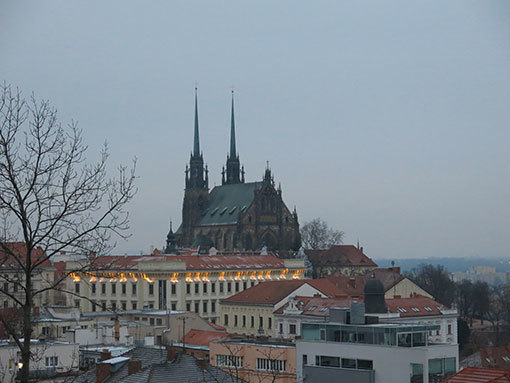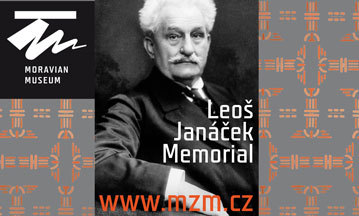To reflect on the oldest history of music in Brno it is perhaps best to go to Moravské náměstí and look at the well-designed relief of the city, capturing its appearance at the time of the Thirty Years War, or imagine Brno in a bird's eye view. Only a few references and names of Brno artists, which remain necessarily discontinuous, have survived from the Middle Ages; therefore it is better to focus on the then key city institutions and their monuments.
The most important and most beautiful testimonies are liturgical books with single-part choral songs. In the 13th century, along with the emergence of the city, religious institutions were also gradually established. The Parish Church of St. James the Greater was designed for a community of originally German colonists since the very beginning of Brno in the first half of the 13th century. The earliest mention of the church dates back to the year 1238, when the Czech King Ottokar I of Bohemia granted the patronage right over it to the Cistercians in Oslavany. The filial church of St. Nicholas was established within as part of the parish of St. James at Velké náměstí, intended probably for Italian traders. The Slavic ethnic group belonged to another city parish in the collegiate church of St. Peter. According to the report of 1298, the school, where the boys were supposed to learn the psalter and singing, had existed in attachment to both churches since time immemorial. After a long period of disputes between the town and the collegiate chapter, the school at the Church of St. James was officially restored in 1466, which does not mean however that it would not have operated in the aforementioned interim period.
The St. James Parish Library, which has been preserved until today, is a treasure whose jewels include primarily liturgical books with notations, often beautifully illuminated. The oldest of them date back as far as the thirteenth century. The psalter may have served the private needs of the owner, a member of the aforementioned monastery of the Cistercian in Oslavany, from where multiple manuscripts reached the Church of St. James. The plea "pray for me, sisters" appears in the texts of prayers in the psalter and the probable origin from the environment of the nunnery is indirectly evidenced by the lack of knowledge of Latin, apparent from some glosses. It was necessary to add other songs to the psalter for use in the Church of St. James so that it could be used by the students of the parish school in the daily singing of the prayer of the hours. A missal with notation, i.e. a liturgical book of missal songs, again of assumed Cistercian origin, dates back to the turn of the 13th and 14th centuries.
The number of liturgical books that the Church of St. James received as gifts increased from the 14th century. Illuminated missals were most frequently made for individual altars, among them a manuscript that originally belonged to the Provost Nicholas, the head of the Petrov chapter. He is shown in the very first initial together with the appropriate legend, the first illustrated initial (Ad te levavi) of the missal. Despite the long-standing rivalry between Petrov and St. James, this manuscript found its way, in an unknown way, into the St. James Library and escaped the destruction that damaged the entire Petrov chapter archives and library in a fire in 1643 (at the aforementioned relief at Moravské náměstí, the Petrov Cathedral or any other nearby buildings do not have roofs, for the same reason).
Around the year 1473, the construction of a new Gothic presbytery and sacristy, above which a singers loft was built, was completed in the Church of St. James. An organist was mentioned in 1475 (its own organ then only after 1490). The collection of liturgical books in the oldest known list (1487–1489) is quite extensive and includes the so-far rather mysterious "cantionale de montibus", literally translated as hymnal from the mountains, perhaps in terms of Kutná Hora, even then important for the local illuminated liturgical books.
Perhaps one of the last relics of the late Gothic is a collection of books from the 1490s, whose exceptionally rich decoration is attributed to the Master of Frederick Breviary and his Brno workshop. Besides the missal intended for the priest, attention should be paid to the gradual, i.e. a book with liturgical songs which had to be divided into two volumes due to its size. The books were originally created as a private gift to a particular altar, but because these were the newest choral manuscripts, the gradual was used for singing even in the following centuries. After 1532, when the patronage right to the parish church was taken over by the Brno city council, even this gradual became an object of city representation, since it received a new embossed forging with the city sign. Unlike today, when these beautiful parchment manuscripts rest in the stillness of the depositary of the Brno City Archive, the books were used for a long time, supplemented and every now and then an occasional – or ambitious – visitor to the St. James Parish Library was able to cut out a page or at least a miniature with an illumination at an unguarded moment.
Although Franciscan and Dominican monasteries were also founded in Brno in the 13th century, of which the former has recently celebrated eight hundred years of local presence, mediaeval liturgical books did not survive. In the Minorites, we will not encounter purposeful care of the music during the service until the beginning of the 18th century when it is the quality music operation performed by its own ensemble that becomes one of the main magnets of the monastery, contributing to the rapid increase in the popularity of the Brno Minorites. On the contrary, the Brno Dominicans apparently did not show significant interest in music in the liturgy and they hired the city's musicians for their masses even during the 18th century.
Therefore, it is necessary to head from Brno city centre at least to the 14th century and behind its original walls. In the example of the Cistercian monastery founded by the Dowager Queen Elizabeth Richeza, it is evident that the masses were the true heart of the community. Thus, it was not enough to build the monastery and church and put together the personnel. Liturgical books, which were taken care of by Elizabeth Richeza, who had them made in one of the scriptoria of the Poor Clares, the female branch of the Franciscan order, were also needed for the monastery to fulfil its function. The peculiarity of this order was that its service followed the pattern of the papal court. Franciscans used choral music of the square shape for their manuscripts and very strict rules applied to the creation of liturgical books. The Dowager Queen herself also established a foundation for eight clergymen (not religious) at the hospital church of the Virgin Mary, who were to participate in choral singing along with the sisters, and the decision to establish a school, whose students would also participate in sacral singing, follows from the Queen's testament from 1330. No later than the end of the fifteenth century, choral singing mixed with playing the organ, the oldest mention of which dates back to 1486 and it is also evidenced by glosses in Elizabeth's manuscripts. Nine of these manuscripts have survived until now, scattered in various places after the monastery closed during the Josephine reforms, when the Augustinians moved to Old Brno from the Church of St. Thomas. An antiphone, a book of songs for the Liturgy of the Hours, is now stored in the Moravian Land Archives, another manuscript was purchased by the famous Moravian historian Gregor Wolny for his Benedictine monastery in Rajhrad (1828) and others ended up in the Austrian National Library by the end of the 18th centuries, therefore sharing similar fates as manuscripts from the Carthusian monastery in Královo Pole founded by the Margrave John Henry.
Rare liturgical books – albeit slowly – have also been preserved in the Augustinian monastery, founded by the Margrave above in 1356. The area of the inner city was already then completely full and therefore the monastery was founded on its outskirts. Shortly after the foundation itself it was ordered that the chorus must have at least 42 monks.
The Margravial Court in Brno also included musicians which can be given at least modest space at the end of this overview. The brother of Charles IV, John Henry, had the pipers Svachek and Nuesek, who bought a house together at the Lower Market (today's náměstí Svobody) in 1355, two trumpeters are also known from the times of the Margrave Jošt besides the two pipers. In the second half of the 14th century, other secular musicians, pipers Lucek and Peček, and the jester Purlenec, documented in 1376 at the periphery in front of the Veselá gate (perhaps somewhere near today's "clock" at Česká) are occasionally reminded of themselves in Brno. Finally, a plate commemorating a certain Blažej Sládek (Blasius Braxator), a musician, who died in 1400, was supposedly located between the Petrov gravestones.
Sources:
František Pokorný: Hudební obraz Brna do počátku 15. století (3 díly), Brno 1991–1993. Jaroslav Mezník: Lucemburská Morava 1310-1423, Praha 1999. Kaliopi Chamonikola (ed.): Od gotiky k renesanci: výtvarná kultura Moravy a Slezska 1400–1550 II., Brno 1999. Jiří Sehnal – Jiří Vysloužil: Dějiny hudby na Moravě, Brno 2001. Stanislav Petr: Soupis rukopisů knihovny při farním kostele sv. Jakuba v Brně, Praha 2007.
Mgr. Vladimír Maňas, Ph.D. is an assistant professor at the Department of Musicology at the Faculty of Arts, Masaryk University, musicologist and historian, dramaturgist of the Easter Festival of Sacred Music and a member of the Ensemble Opera Diversa.
































